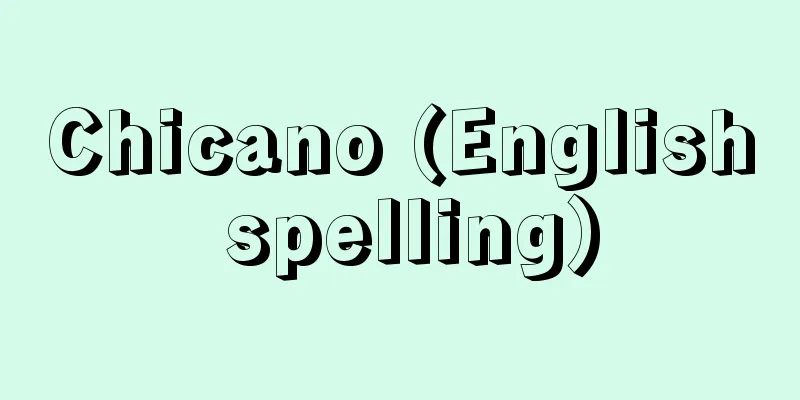Chicano (English spelling)

|
A general term for Mexican Americans. A term that became established in the 1960s and 1970s. According to the 2000 census, the Chicano population was about 9.2 million (about 8.75 million in the 1980 census), making them the second largest group in the United States in terms of population among the groups that suffer racial and ethnic discrimination and oppression. Since Mexicans themselves are made up of Indians, Spanish colonists, Africans (blacks), and mestizos and mulattos born from intermarriage between them, it must be noted that Chicanos also inherit and share the cultural traditions of Spain and Mexico, such as Spanish language and Catholicism, but are made up of a very diverse population in terms of race. The Chicano population is concentrated in the Southwestern United States, particularly California (3.637 million people in the 1980 census) and Texas (2.752 million people in the 1980 census), but large numbers also live in industrialized Midwestern states such as Illinois and Michigan, where urbanization and the shift to industrial labor are progressing rapidly. [Hideyuki Otsuka] Origins of ChicanosThe vast southwestern region of the United States, consisting of the states of Arizona, California, Colorado, New Mexico, Texas, Nevada, Utah, and parts of Kansas, Oklahoma, and Wyoming, was transferred from Mexico to the United States through the annexation of Texas, the conquest and annexation of northern Mexico, and the Gadsden Purchase between 1845 and 1854. As a result, Mexico, which had only recently gained independence from Spain, lost the northern half of its territory, and the estimated 80,000 Mexicans living in the area were Americanized through the conquest and annexation. Chicanos are made up of these conquered Mexican ethnic groups, immigrants from Mexico who continued to be under strong political and economic control from the "Northern Giant," the United States, and the children of both. [Hideyuki Otsuka] The growth of the Chicano populationThe Chicano population increased rapidly due to the large-scale immigration from Mexico. The United States gradually strengthened immigration restrictions from the beginning of the 20th century, but the Western Hemisphere was excluded from the restrictions, so the number of immigrants from Mexico reached nearly 500,000 in the 1920s. During the Great Depression that began in 1929, immigration was restricted and Mexican residents with U.S. citizenship were even deported. However, after the outbreak of World War II, the introduction of Mexican workers, known as the "Bracero Plan," was promoted by an agreement between the U.S. and Mexican governments to alleviate the labor shortage in the United States, especially in agricultural labor. The agriculture of the Southwest, which specialized in fruit and vegetable production, required a large number of harvesters during the harvest season, and the industrialization of the Southwest, which began during World War II, continued after the war (the Southwest became the "Sunbelt"), so the demand for Mexican workers increased, and more than 4.5 million Mexican immigrants entered the country in the 1960s and more than 5.8 million in the 1970s. In addition to legal immigration, there are also believed to be large numbers of Mexicans illegally entering the United States. Mexico became the largest source of immigrants to the United States after the war, which led to a rapid increase in the Chicano population. [Hideyuki Otsuka] [References] | | |Source: Shogakukan Encyclopedia Nipponica About Encyclopedia Nipponica Information | Legend |
|
メキシコ系アメリカ人Mexican Americanの総称。1960~70年代に定着した用語。2000年の国勢調査によれば、チカノ人口は約920万人(同1980年調査では約875万人)で、アメリカ合衆国において人種的・民族的な差別と抑圧を受けている諸集団のなかでは、人口数で黒人に次ぐ集団である。メキシコ人そのものが、インディオ、スペイン植民者、アフリカ人(黒人)、および彼らの間の混血によって生まれたメスティソやムラートから成り立っているため、チカノも、スペイン語やカトリックなどスペインおよびメキシコの文化的伝統を継承・共有しているが、人種的には甚だ多様な人々から成り立っていることに注意せねばならない。チカノ人口は、合衆国の南西部、ことにカリフォルニア州(363.7万人=1980年調査)やテキサス州(275.2万人=1980年調査)に集中しているが、イリノイ州やミシガン州など工業化の進んだ中西部の諸州にも多数住んでおり、都市化・工業労働者化が著しく進行している。 [大塚秀之] チカノの起源アメリカ合衆国の南西部一帯、すなわちアリゾナ、カリフォルニア、コロラド、ニュー・メキシコ、テキサス、ネバダ、ユタの各州、およびカンザス、オクラホマ、ワイオミング諸州の一部からなる広大なこの地域は、1845年から54年にかけて、テキサス併合、メキシコ北部の征服と併合、ガズデン購入などを通じ、メキシコ領からアメリカ合衆国領へと編入・併合された。この結果、スペインから独立してまもないメキシコは、領土の北半分を喪失し、この地に住む約8万人と推定されるメキシコ人が、征服と併合によりアメリカ人化されたのであった。チカノは、この、征服されたメキシコ人民族集団と、「北方の巨人」アメリカ合衆国から引き続き強い政治・経済上の支配を被ってきたメキシコからの移民と、そして両者の子供たちとから成り立っている。 [大塚秀之] チカノ人口の増大チカノは、メキシコからの大量の移民によって、その人口を急激に増加させた。アメリカ合衆国は、20世紀に入ってからしだいに移民制限を強めていくが、西半球は制限から除外されたため、1920年代にはメキシコからの移民は50万人近くに達した。29年に始まる大恐慌期には、移民は抑制されたうえ、合衆国の市民権をもつメキシコ系住民の強制送還さえ行われたが、第二次世界大戦の勃発(ぼっぱつ)以後、合衆国の労働力、とりわけ農業労働力不足を緩和するため、「ブラセロ計画」とよばれるメキシコ人労働者の導入が、アメリカ、メキシコ両国政府の協定により推進された。果実や野菜生産に特化した南西部の農業は、収穫期に大量の収穫労働者を必要としたうえ、第二次世界大戦中から始まる南西部の工業化が戦後も引き続き進行した(南西部の「サンベルト」化)ため、メキシコ人労働者に対する需要は増大し、60年代には450万人強、70年代には580万人強ものメキシコ人移民が入国した。また、正規の移民に加え、合衆国に密入国するメキシコ人も、膨大な数に上るとみられている。メキシコは、戦後の合衆国への移民の最大の供給源となり、これが、チカノ人口の急激な増加を引き起こしたのである。 [大塚秀之] [参照項目] | | |出典 小学館 日本大百科全書(ニッポニカ)日本大百科全書(ニッポニカ)について 情報 | 凡例 |
<<: Chika Island - Chika Island
>>: Chikanagakyouki - Chikanagakyouki
Recommend
SS (Nazis)
In this period, the conservatives who remained in...
Yamanakabushi
This folk song has been sung in the Yamanaka Onse...
Contemporary music
In contemporary art, the interpretation of "...
Hanslick
Austrian music aesthetician and music critic. Afte...
Ichikawa Danjūrō (11th generation)
[Born] 1909 [Died] November 10, 1965. Kabuki actor...
Ichizo Kobayashi
Businessman. Founder of the Hankyu Toho Group (no...
Rissho University
It is a private institution. Its founding dates b...
Akaiwa Seigankyo Gorge - Akaiwa Seigankyo Gorge
...There is a village-run wild vegetable factory,...
Mount Daitenjo
A mountain in the southeastern part of the Northe...
Finless porpoise (finless porpoise)
A mammal of the family Porpoiseae (illustration) i...
Q blood type
…He served as professor at Kanazawa Medical Colle...
Erg (desert) - erg
… Deserts can be classified into sandy deserts, g...
Weimaraner [species] (English spelling)
A hunting dog originating from Germany. During the...
splicing
…Therefore, even in the RNA molecule (heterogeneo...
Horikin [village] - Horigane
A village in Minamiazumi County, western Nagano Pr...









